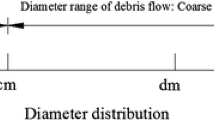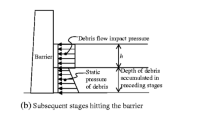Abstract
A model of debris flow risk zoning is carried out with momentum analysis of debris flow. This model zones the debris flow inundation fan with density and velocity calculated by numerical simulation. The risk classification standard is determined according to the ultimate bearing capacities of different structures under impacting. And the ultimate bearing capacities are tested by impact failure experiment of destruction. Two structures typical in Chinese mountain towns, reinforced concrete frame construction and brickwork with concrete, are chosen in the experiment. The model makes debris flow risk zoning quantitative and the results comparable widely. The results differ much from that of other methods especially in the identification of medium and low risk zones.
Similar content being viewed by others
References
O'Brien J S, Julien P Y, Fullerton W T. Two-Dimensional Water Flood and Mudflow Simulation [J].Journal of Hydraulic Engineering, 1993,119(2): 244–261.
FLO-2DF Software, Inc. FLO-2D User'S Manual[EB/OL]. [2002-05-22].http://www.flo-2d.com.
Hübl J, Steinwendtner H. Two-Dimensional Simulation of Two Viscous Debris Flows in Austria [J].Physics and Chemistry of the Earth, Part C, 2001,26(9): 639–644.
Canuti P, Casagli N, Catani F,et al. Modeling of the Guagua Pichincha Volcano (Ecuador) Lahars [J].Physics and Chemistry of the Earth, Parts A/B/C, 2002,27(36): 1587–1599.
Tang C, Liu X. The Evaluation and Application of Risk Degree for Debris Flow Inundation on Alluvial Fan [J].Journal of Nature Disasters, 1993,2(4): 79–84 (Ch).
Tang C, Zho J. A Study on the Risk Zoning of Debris Flow on Alluvial Fans by Applying Technology of Numerical Simulation [J].Journal of Catastrophology, 1994,9(4): 7–13 (Ch).
Kienholz H. Anmerkungen zur Beurteilung von Naturgefahren in den Alpen [J].Relief Boden Pal oklima, 1999,14: 165–184 (in German).
BUWAL/BWW/BRP.Berúcksichtigung der Hochwassergefahren bei raumwirksamen Tätigkeiten [M]. Bern: BUWAL, BWW, BRP, 1997: 42 (in German).
Rickenmann D. Methoden zur Gefahrenbeurteilung von Murg ngen [J].Mitteilungen des lehrstuhls und Instituts für wasserbau und Wasserwirtschaft Rheinisch-west fälische Technische Hochschule Aachen, 2001,124: 51–77 (in German).
Wei F, Hu K, Lopez J L,et al. Method and Its Application of the Momentum Model for Debris Flow Risk Zoning [J].Chinese Science Bulletin, 2003,48(6): 594–598.
Hu K, Wei F, He Y,et al. Application of Particle Model in Risk Zoning of Debris Flow [J].Journal of Mountain Sciences, 2003,21(6): 726–730 (Ch).
Zhou B, Li D, Luo D,et al. Manual of Debris Flow Control Works [M]. Beijing: Science Press, 1991: 51–52 (Ch).
Profession Standards of China.Design Standards of Flood Control Works for Towns (CJJ50-92) [S]. Beijing: China Planning Press, 1993: 2–3 (Ch).
Zhang S, Yuan J. Debris Flow Impact Force and Its Detection [M]// Memoirs of Lanzhou Institute of Glaciology and Cryopedology.Chinese Academy of Sciences (Special Issues of China Debris Flow). Beijing: Science Press, 1985: 269–274 (Ch).
Profession Standards of China.Design Standards of Concrete Structure (GB50010-2002) [S]. Beijing: China Architecture & Building Press, 2002: 9–27; 41–82; 113–119; 129–140; 165–180 (Ch).
Profession Standards of China.Standards of Load of Building Structure (GB500009-2001) [S]. Beijing: China Architecture & Building Press, 2002: 6–16; 24–40 (Ch).
Profession Standards of China.Design Standards of Bricking-up Structure (GB50003-2001) [S]. Beijing: China Architecture & Building Press, 2002: 10–43; 78–81 (Ch).
Author information
Authors and Affiliations
Corresponding author
Additional information
Foundation item: Supported by the National Natural Science Foundation of China (40201009)
Biography: WEI Fangqiang (1968-), male, Professor, research direction: theory and technology of mountain hazards mitigation.
Rights and permissions
About this article
Cite this article
Fangqiang, W., Yu, Z., Kaiheng, H. et al. Model and method of debris flow risk zoning based on momentum analysis. Wuhan Univ. J. Nat. Sci. 11, 835–839 (2006). https://doi.org/10.1007/BF02830173
Received:
Issue Date:
DOI: https://doi.org/10.1007/BF02830173




